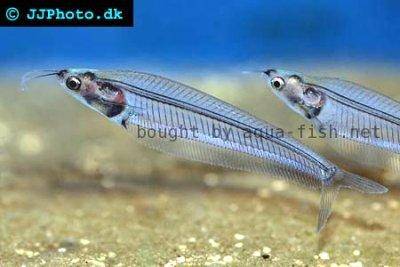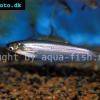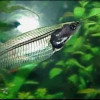Ghost catfish - Kryptopterus minor
Scientific name: Kryptopterus minor
Common name: Ghost catfish
Family: Siluridae
Usual size in fish tanks: 6 - 7 cm (2.36 - 2.76 inch)
014
Recommended pH range: 6 - 7.2
Recommended water hardness: 3 - 10°N (53.57 - 178.57ppm)
0°C 32°F30°C 86°F
Recommended temperature range: 24 - 27 °C (75.2 - 80.6°F)
The way how these fish reproduce: Spawning
Where the species comes from: Southeast Asia
Temperament to its own species: peaceful
Temperament toward other fish species: peaceful
Usual place in the tank: Middle levels
Short description
The Ghost Catfish (Kryptopterus minor) is a translucent, schooling silurid famed for its glass-like body. It prefers dimly lit aquaria with gentle flow and dense plant cover. Keep in a group of at least 8–10 to prevent stress and “freezing” behavior. Note that the trade often confuses glass catfish species; the common “glass catfish” is frequently Kryptopterus vitreolus (smaller Thai species), while K. bicirrhis is larger and less transparent. Correct identification matters for size and care expectations.
Minimum tank size & aquascape
- Minimum tank (shoal): 80–100 L with ≥75–90 cm length; larger volumes improve stability.
- Layout: Dark substrate, driftwood roots/branches, fine-leaved or floating plants for shade (e.g., Ceratopteris, Salvinia, Pistia, Taxiphyllum), and open midwater lanes.
- Flow & lighting: Gentle to moderate current; subdued lighting or floating plant cover.
Water parameters
Soft, slightly acidic to neutral water suits them best: pH 6.0–7.2, 3–10 °dGH, 24–27 °C. Low nitrate and high oxygen are crucial. Perform steady, modest water changes (20–30% weekly) and avoid sudden shifts.
Diet (Food & feeding)
Although they will learn to take quality micro-pellets and fine flakes, they thrive on small live/frozen fare: daphnia, cyclops, baby brine shrimp, mosquito larvae, and finely chopped bloodworms/mysis. Offer multiple small feedings so shy individuals get their share. Avoid aggressive, fast feeders that outcompete them at mealtime.
Behavior & compatibility
- Schooling: Keep 8–10 ; solitary or tiny groups become timid and prone to wasting.
- Tank mates: Calm, non-nippy species from similar conditions: harlequin rasboras (Trigonostigma), peaceful danionins (Devario/Danio with mild activity), small gouramis (Trichogaster/Trichopsis), kuhli loaches (Pangio), and small peaceful catfish.
- Avoid: Fin-nippers (e.g., tiger barbs), large cichlids, or hyperactive predators; anything that can swallow a 6–7 cm slender fish.
Sexing
No reliable external differences; ripe females may appear slightly deeper-bodied. Venting is occasionally cited but impractical for hobbyists.
Breeding
Captive spawning is rare and poorly documented. In nature they are believed to be egg-scatterers among vegetation during rainy-season cues. If attempted, use a large, mature, soft-water setup with dense fine plants or spawning mops, gentle flow, and a live-food–rich diet. Remove adults post-spawn; fry require microscopic foods (infusoria/rotifers), later newly hatched brine shrimp.
Regional plants (South/South-East Asia)
Use shade-tolerant species: Ceratopteris thalictroides, Cryptocoryne spp., Hygrophila spp., Microsorum pteropus (Java fern), Taxiphyllum barbieri (Java moss), and floating plants (Salvinia, Pistia). These help diffuse light, reduce stress, and support natural foraging.
Care level
Intermediate. They are peaceful but sensitive to poor water quality, sudden parameter shifts, and pushy tank mates. Prioritize group size, calm company, and stable, clean water.
Notes on identification
The trade label “glass/ghost catfish” has long been used for multiple species. Confirm morphology and origin where possible. K. minor remains small (6–7 cm) and fully translucent; K. vitreolus is similar but Thai in origin; K. bicirrhis reaches ~12–15 cm and is not truly “glass-like” when mature.
Pictures
Bought by aqua-fish.net from jjphoto.dk.





 Blue
Blue  Glass
Glass